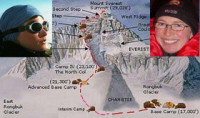
This past winter, the ExplorersWeb ran the "
Killer Mountains" series. They became some
of their most popular articles. The series investigated the
summit/fatalities statistics of the 14, 8000ers. But which of the 14 mountains
is the deadliest? And how dangerous are the mountains after all?
Photo. Image of Everest, ExplorersWeb files and Big
Mac, courtesy of solstikkan.tripod.com
Click on the link to see the summary of the statistics, and a few
other interesting statitistics to consider: www.mounteverest.net/story
Also females are willing to take the risk to reach
ambitious personal goals. Travel Explorations covered recently the
expeditions to two Norwegian females, Skog and Skaug, who reached the
top of Mt. Everest as
the first females in the history.
|
Photo. Two Norwegian females, Skog and Skaug,
made it to the top of Mount Everest in May this year. |
 |
They really survived! At the same time several climbers were
reported missing and dead. It`s like "Russian Roulette" (Rulett). You
never know who is going to live or die. People who are taking such risk are more
afraid of not living than dieing.
Based on ExplorersWebs analysis it seems to be a high
death rate climbing high mountains, but compared with other statistics it
seems to be more risky to live "normal"????
Stein Morten Lund, 5 June 2004
Additional information
Get the hottest news and the best information about
climbing, sailing, polar expeditions, medicine, equipment and weather
at Explorersweb: www.explorersweb.com
